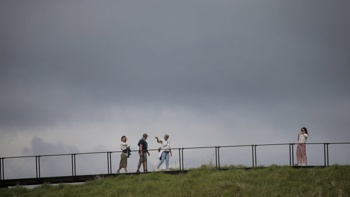Forecasters have assessed a “high” risk of more cyclones developing in the tropics from the back half of next week – but that doesn’t mean New Zealand is in for a third unwelcome visit.
“While Cyclone Gabrielle has now dissipated completely, we must remember that we are still in the middle of the South Pacific Oceans’ tropical cyclone season,” MetService meteorologist Lewis Ferris said.
Historically, late February and early March marked the height of our November-to-April cyclone season.
In a given week around this peak period, chances of a cyclone being present in the southwest Pacific was typically at least 50 per cent.
For the rest of this week, however, the tropical area to the north of New Zealand looked to remain quiet.
“We have assessed a ‘very low risk’ of any cyclone development for this week and weekend, this is the lowest risk available,” Ferris said.
“The first few days of next week remain the same, but the risk of cyclone development does increase in the second half of next week.”
MetService had assessed risk from that point – or from March 1 – as high, with chances greater than 50 per cent.
Still, this didn’t necessarily mean New Zealand was in danger again.
“Tropical cyclone development always happens very far away from New Zealand, so even if we do see a tropical cyclone develop next week that does not mean it will affect Aotearoa,” Ferris said.
“Most tropical cyclones never impact our weather, but every storm follows a unique path, and some get close enough to have a say.”
Niwa meteorologist Ben Noll said the current lower risk was partly down to a “suppressed” phase in the west-central Pacific – but one that’d be replaced by a short-lived active phase in early March.
“Of course, that doesn’t guarantee a cyclone nor an impact in New Zealand, but it increases the risk overall.”
Each season, around nine cyclones formed up in the southwest Pacific, of which least one travelled within 550km of our country.
But this season had come with an elevated risk, with Niwa warning at its outset that one to two systems could head our way – as had since come to pass with Gabrielle and Hale.
Much of that could be explained by the current state of our tropical ocean waters.
“We are currently in a La Niña phase, which is conducive to tropical cyclones forming in and around the Coral Sea near Vanuatu and New Caledonia,” MetService meteorologist Lisa Murray explained.
“This is a breeding ground for many of the cyclones that have impacted Aotearoa New Zealand historically.”
While La Niña was likely to fade to a “neutral” climate state over the next month, Murray said there wouldn’t be a tangible change to our weather maps through the rest of summer, given the atmosphere essentially had to “catch up”.
Meanwhile, forecasters were picking the potential for big rain-makers around the first week or two of March – owing not to cyclone risk, but another more frequent occurrence in our climate system.
That was the Madden Julian Oscillation (MJO) – a pulse of rain and thunderstorms that circled the globe every 30 to 60 days – passing above New Zealand over that period.
The historic storm that brought Auckland’s wettest day on January 27 happened to coincide with a visiting MJO - but its influence on New Zealand still depended on there being local low-pressure systems to ferry that subtropical moisture down here.
Before that, some models were showing a risk of more heavy rain for the North Island’s East Coast - with potential for as much as 50mm for Wairoa over Friday and Saturday.
“There’s a lot of uncertainty, but it’s not good news,” MetService meteorologist Alwyn Bakker said.
“Any rain certainly won’t help,” Bakker said, given the areas which could potentially be hit include cyclone-ravaged Hawke’s Bay and Gisborne.
“We know people look at [weather] models online, and you may be seeing [predictions of heavy rain], but rest assured: we’re monitoring it.”
Take your Radio, Podcasts and Music with you









